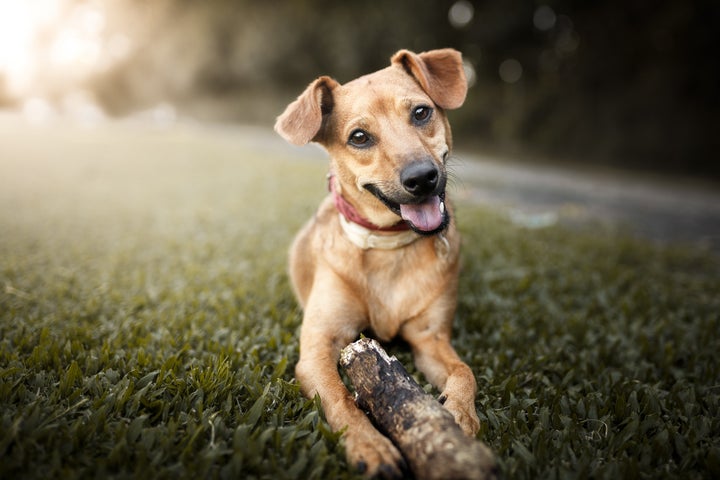With Hurricane Florence drawing closer to Georgia and the Carolinas, many people are scrambling to make accommodations for themselves, their families and their pets. Evacuating with pets, or weathering out the storm with them, can be challenging, though knowing what to do ahead of time can make a huge difference.
Here are some general guidelines on how to prepare to care for your furry or feathered loved ones during a big storm.

If You Are Evacuating
Do NOT leave your pets behind.
If it isn’t safe for you to be at home in a natural disaster, it isn’t safe for your pets.
“If you are forced to evacuate, bring your pet with you,” Dick Green, disaster response senior director with the American Society for the Prevention of Cruelty to Animals, said in a statement sent to HuffPost. “Never leave your pet behind.”
Beside the risks during a storm, you never know exactly how long it could be before you get back. During Hurricane Katrina, for instance, some people who fled left their pets behind in a secure area in their homes because they believed they would return in a day or two. When they weren’t allowed back for much, much longer, some of those animals ended up dying of thirst or hunger.
Above all, never leave animals tied or chained outside, which can be a death sentence in the face of rising waters.
Know where you can go with your pets.
If you aren’t lucky enough to have a friend or relative who will take you in, it’s crucial to figure out ahead of time somewhere else you can go with pets.
The Pets Evacuation and Transportation Standards Act mandates that the Federal Emergency Management Agency include plans for pets in preparation for federal disasters. However, there is a lot of confusion around what this law means. It does not mean that private companies, like hotels, have to make special accommodations for pets ― though some hotels may choose to do so in times of crisis. If you are planning to head to a hotel, check ahead of time whether they are accepting pets. You can also check Airbnb for pet-friendly homes by selecting “Pets allowed” under the “House Rules” filter.
The PETS Act also didn’t change regulations around air travel. Though airlines sometimes loosen their restrictions on pets in the face of natural disasters, they don’t always. Look into the individual airline’s policies before attempting to fly with your pet.
Some emergency shelters for people accept pets, but not all do. And in some cases, emergency shelters partner with local animal shelters or veterinary offices to temporarily board pets during a storm.
Pet rescue group Red Rover has compiled a list of pet-friendly shelters, as well as other resources for pet owners, in North Carolina, South Carolina and Virginia. Check local media to find more information about specific shelters in your area. Note that some shelters also require proof of specific vaccinations, like rabies shots.
Prepare what you will bring.
Gather all the supplies you’ll need for your pet ― and yourself, for that matter ― well before the storm hits.
Make sure that pets are wearing ID tags with your contact information and that you have carriers, leashes and a pet “go bag” ready. Of course, the supplies you’ll need will vary depending on the type of animal you have. In addition to a leash (if applicable) and a traveling bag, crate or sturdy carrier (preferably one for each pet), Green suggested that a go bag include:
Enough pet food for five to seven days in a sealed container
At least seven days’ worth of bottled water for each person and pet
Photocopies and/or a USB flash drive of medical records and a waterproof container with a two-week supply of any medicine your pet requires
Recent photos of your pets (in case you are separated and need to make “Lost” posters)
Pet-safe cleaning supplies, including disinfectant, garbage bags, wee-wee pads and paper towels
Food and water bowls
Comfort items, including a blanket and toys
A portable litter box for cats or rabbits would also be a good addition. Head over to the American Society for the Prevention of Cruelty to Animals site for more information about special considerations during natural disasters for less common pets like birds and reptiles.

If You Are Not Evacuating
Even if you aren’t evacuating, you’ll still want to make preparations to ensure your pets are safe in your home.
Prepare to evacuate if necessary.
During a natural disaster, the unexpected can always happen. Have a plan in place, including where you will go, in case you suddenly have to evacuate with your pets, and get that emergency go bag ready.
Bring your pets inside.
You don’t want your animals outside when a hurricane hits.
“All pets should remain inside before, during and after the storm, and they should be wearing a collar and ID tag in case they become skittish and escape,” said ASPCA spokeswoman Alyssa Fleck.
Make sure they’re contained within your home well before the storm hits. During the storm, bring your pets with you into a safe room with no, or few, windows, the Centers for Disease Control and Prevention advises.
You’ll also want to be able to grab your pets quickly if you have to evacuate. Make sure to have items like leashes and carriers close by and ready to go.
Stock up on supplies.
When you stock up on bottled water and nonperishable foods for yourself, make sure you also get plenty of food and water for any animals who depend on you, plus any medications they take. Don’t forget other types of supplies, like cat litter or small animal bedding.
Make your pet comfortable.
Big storms can be scary for animals. Try to stay calm around your pets, talk to them in a comforting voice, and have familiar items like blankets, beds and toys readily available. As Red Rover notes, some animals ― especially cats ― may be too spooked to want to cuddle with you. In those cases, let them interact with you on their own terms.
But don’t lose track of them entirely. Cats often cope with stress by hiding, and you don’t want them to end up in places where they could become stuck or you couldn’t get to them immediately if necessary.
Though you may be tempted to tranquilize your pet, that could do more harm than good, since your pet may need to be alert in a worst-case scenario.

Longer-Term Planning
Even if a hurricane is not heading your way right now, it’s never a bad time to prepare to care for your pets during a natural disaster. Here are some things you can do well ahead of any storm to make sure you’re ready if and when catastrophe strikes.
Microchip your pet.
Microchips are tiny implants containing identification information that can be scanned by vet’s offices or animal shelters should your pet become lost. They can be implanted at a vet’s office, and the procedure doesn’t hurt any more than a routine shot. If your pet get a microchip, you’ll then need to make sure the information on the chip stays up to date. You should receive directions on how to do this when your pet receives the chip.
Prepare a disaster kit or go bag.
See above for what your disaster kit should contain. Green noted that it should be stored in a cool, dry area and that items like food and medication will need to be swapped out periodically to ensure they don’t expire.
Get your pet familiar with a crate or carrier.
Evacuating is far less stressful when your pet isn’t terrified of the carrier ― a response that often arises when the animal associates the carrier only with trips to the vet or other unpleasant car rides. There are many detailed guides on how to get pets comfortable with crates or carriers. Some of the basic steps include leaving the object out all the time so it becomes familiar and getting your pet to associate it with positive experiences like treats.

